- 24 April 2016
- Magazine

For the past few months, archaeologists have been testing a full head of hair found in a coffin. Is it the hair of a saint?
In October 1839, the work of some gravediggers came to an abrupt halt when their tools hit something hard. It was a lead coffin. Inside they found some hair. Human hair.
In the year 2000, a seven-year-old boy called Jamie Cameron went on a school trip to his local parish church, Romsey Abbey in Hampshire. It was where the gravediggers had made their discovery more than a century and a half earlier.
He was taken to a display case and was immediately drawn to the full head of hair, which was still resting on the oak "pillow" on which it was found.
The curious exhibit helped persuade that school boy to pursue a career in archaeology.
"I thought one day when I'm grown up I might be in a position to be able to try and work out who this person might have been."
Jamie Cameron is now 23 and an archaeological scientist, having studied at both Cambridge and Oxford. And he has been trying to find an answer to that question which has bugged him for years.
The hair is shaped as if it is still sitting on a head but there is no skull. According to the archaeologists, the white bits - visible in the photos - are the remains of the scalp. There is even a plait which is several inches long.
Find out more
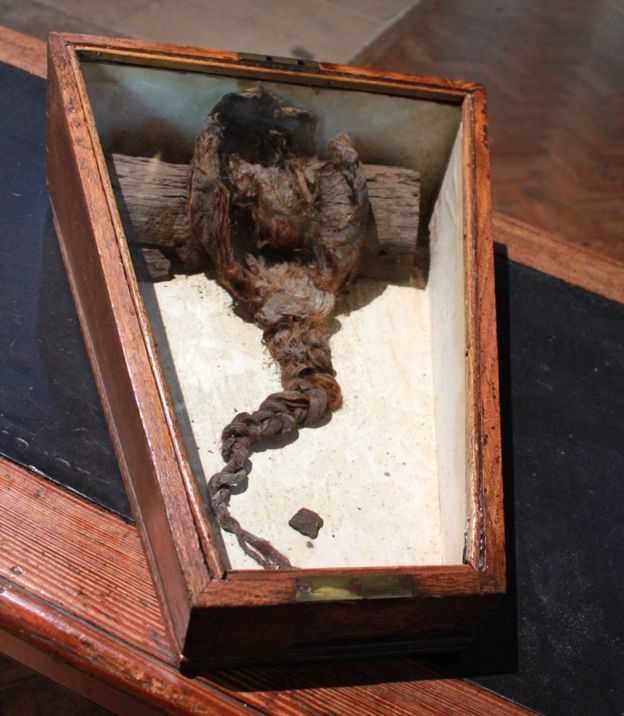
You can listen to Jon Manel's full report on BBC Radio 4's Broadcasting House, on Sunday 24 April at 09:00 or catch up afterwards on iPlayer.
When it was originally uncovered deep beneath the abbey, it was thrown as rubbish into the coal hole before someone thought it should be rescued and fished it out again.
Romsey Abbey is actually almost like a cathedral - a vast, beautiful, largely Norman building, in a town not far from Southampton. One of the gravediggers who discovered the hair there in 1839 - a Mr J Major - wrote about what happened. This is his account, edited but in his words and with his spellings.
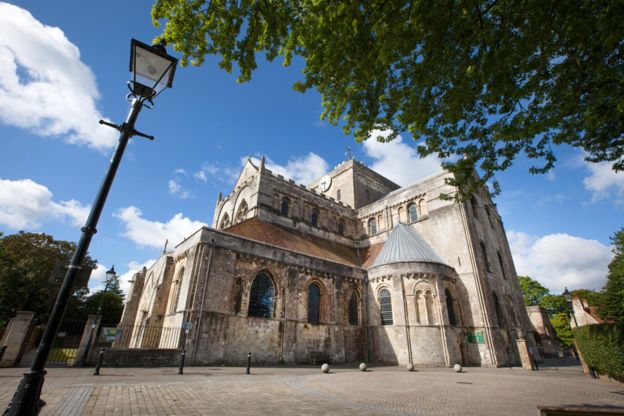 Alamy
Alamy
"Wee began the work with the pickax and shovell, witch is the proper tools for excavation. Wee came on a led coffin. I acquainted the Vicar of the discovery. I was to find if thare was any bones in it. If so, it was not to be removed. I tried by making a hole on the top. I thrusted my hand to the head of the coffin to find the scull. I found no bones but a scalp of feamial [female] hair as bright as any living ladies hair I have ever seen. There was 1 finger bone. It became dust immediately the air came to it. This is a Trew History of the hair and the coffin."
Until now, though, there's been a big gap in that "Trew History". Based on the part of the abbey where the coffin was found, many believed it probably dated back to Saxon times. Others thought it might have been Roman.
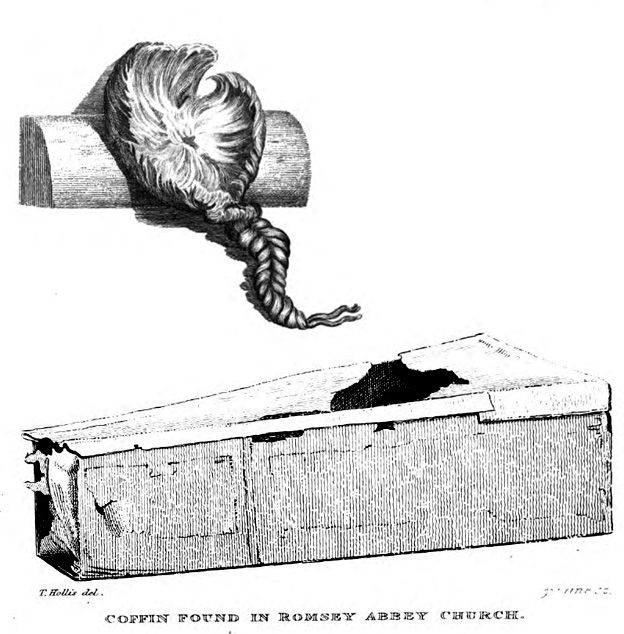
There have been theories about who the hair might have belonged to but nothing more than that. Frank Green, who is the archaeological adviser to Romsey Abbey, has been wondering about it for years.
"[We've always believed] it was a person of some significant status because there was originally an outer wooden coffin and an inner wooden coffin inside the lead one."
Over the years there has been speculation that it was the hair of a saint.
"The two saints are St Morwenna who was the first abbess here and St Ethelflaeda, who is our patron saint," Romsey's vicar, Reverend Canon Tim Sledge, explains.
"And I think that's the rather romantic, hopeful, aspirational thing about this. These two saints are unique to Romsey - no one else has ever heard of them. They are our two saintly celebrities."
Years after becoming fascinated with the hair as a seven-year-old, Cameron was finally able to come back and test it.
Dressed in the kind of white body suit worn by forensic police officers, he opened up the display case, took the hair out of its wooden framed glass box and cut off a small sample.
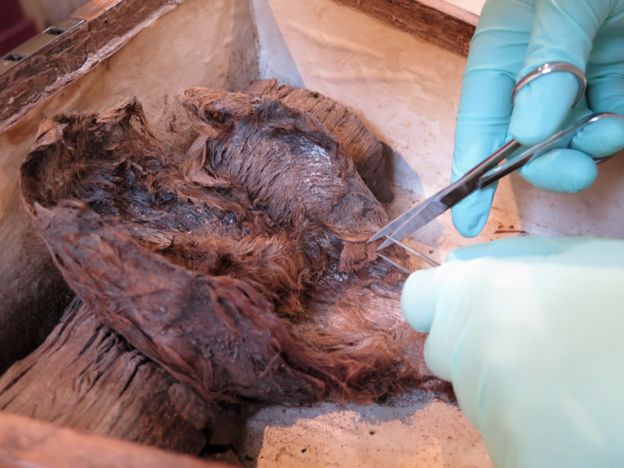 Dr Georges Kazan
Dr Georges Kazan
That was passed to a team of archaeological scientists at Oxford University's "Relics Cluster". They carry out tests on all sorts of things, from fragments of bone to pieces of wood and cloth - and hair.
In the Research Laboratory for Archaeology, Dr Thibaut Deviese prepared some of the dark oily residue which was found on the hair - a process that lasted several hours. It was then put into an oven-like machine for gas chromatography mass spectrometry (GCMS). This separates out all the molecules, which are then displayed on a graph.
"It seems based on this analysis that there was pine resin in the hair of this person," says Deviese. The pine resin may have come from overseas, Cameron suggests.

GCMS is only one of the tests. Most important of all has been the radio carbon dating, to find out when the person with the hair lived.
"The radio carbon tests that we carried out suggest something in the mid to late Saxon era," Cameron reveals.
The results showed that the person almost certainly died sometime between the years 895 and 1123. To be slightly more specific, there is a 68.2% probability that the death occurred between 965 and 1045.
The tests also revealed what this person might have eaten.
"We managed to find signals which are indicative of marine protein, so fish," says Cameron.
And then there was the pine resin. "We can't tell whether that was something to do with the funerary ritual or hair care during life."
The crucial question though is whether this scientific analysis has brought us closer to knowing who it was who was buried in that lead coffin. The abbey's archaeological adviser, Frank Green, thinks it has.
"The fact that this person had a marine diet could be very specific to perhaps members of the monastic community.
"And the context of the burial in what would have been the south transept of the previous building right against the abbesses' doorway, strongly suggests it's someone linked to the monastic community."
So, 177 years after Mr Major and his fellow gravediggers found the hair, we finally knew a bit more about it. It was the hair of a Saxon but which one?
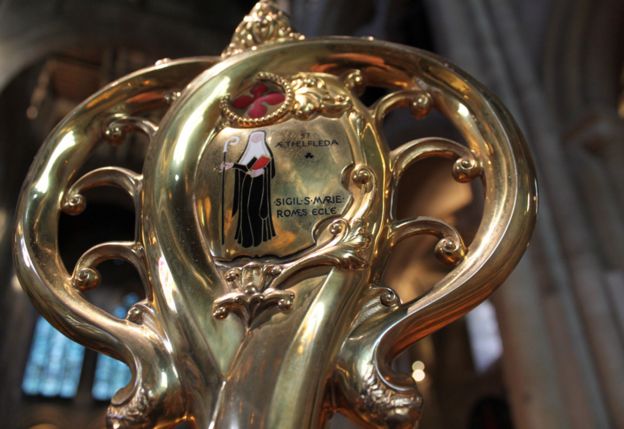
"I think many people would like to think it is St Ethelfaeda," Green says. "It could well be that it is her burial."
But the tests have not revealed enough for the archaeologists to be able to say that for sure.
As Green points out, if this was the burial of the abbey's patron saint, why was the grave not the focus of religious activity and great reverence over the generations?
There may be more information about the hair to come. "It may be possible to perform some DNA analysis in the future," Cameron says.
Hairstyles have changed of course over the centuries so the assumption that the plait suggests the hair came from a woman could yet prove to be wrong.
It is not possible then to put a new sign on the old display case with a specific name - but there is at least now more of a story to tell the children on those school trips to the abbey.

No comments:
Post a Comment